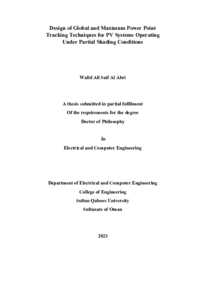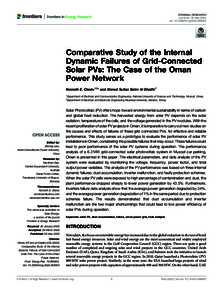وثيقة
Design of global and maximum power point tracking techniques for PV systems operating under partial shading conditions.
المصدر
Doctoral dissertation
عناوين أخرى
تصميم تقنيات تتبع الطاقة القصوى لأنظمة الطاقة الشمسية تعمل تحت ظروف الظلال الجزئية
الدولة
Oman
مكان النشر
Muscat
الناشر
Sultan Qaboos University
ميلادي
2023
اللغة
الأنجليزية
نوع الرسالة الجامعية
Doctoral dissertation
الملخص الإنجليزي
Renewable energy plays an increasingly important role in achieving
sustainable development, ensuring energy security, and controlling greenhouse gas
emissions. Solar energy is widely used source for electricity production due to
continuous advancements in solar power technology and decreasing costs.
Additionally, advancements in PV panel and inverter designs have made it possible to
invest in low-insolation areas.
Partial shading conditions (PSCs) can significantly reduce the energy output of
photovoltaic (PV) systems. Conventional and advanced MPPT systems often fail to
operate PV systems at their peak performance during PSCs due to the conduction mode
of bypassi diodes, which can trap the PV system at a low power point. However, global
peak searching tools can enable the operation of PV systems at the GMPP. It is
important to note that frequent use of these tools may decrease the output of PV
systems, as they force the system to operate outside its power region during the
scanning of the I-V curve to determine the GMPP. Therefore, global peak searching
tools should only be deployed when PSCs occur.
In this thesis, a simple and accurate method for detecting PSCs is proposed by
monitoring the sign of voltage changes. The method predicts a PSC if the sign of
successive voltage changes remains the same for a certain number of successive
changes. The proposed method was tested on two types of PV array configurations
(series and series-parallel) with various emulated shading patterns. The method
successfully and timely identified all emulated shading patterns and outperformed a
detection method based on monitoring the normalized change in power. It can be used
to trigger GMPP searching techniques for improving the output of PV systems under
PSCs.
Machine learning tools, such as fuzzy logic control and neural networks, have
been used in numerous studies to enhance conventional MPPT methods and optimize
PV systems under PSCs. However, these methods are complex to implement as they
require intensive calculations and exhibit limitations in ensuring GMPP operation
under all PSC conditions. To address this, a light and fast GMPP searching method
based on Bald Eagle Searching (BES) is proposed in this thesis. The BES method
locates the maximum value in three stages: selecting space, searching in space, and
swooping. The first stage of the BES method is utilized to design the proposed GMPP
method. MATLAB results demonstrate that the BES technique outperforms Cuckoo
Search (CS) and Particle Swarm Optimization (PSO) methods, reducing search time
significantly and successfully finding the GMPP in all simulated PSC cases. The
proposed method is simple, easy to implement, and only requires a single tuning
parameter, distinguishing it from PSO and CS methods. A validation method using a
real-time digital simulator (RTDS) confirms the capability of the proposed method to
find the GMPP within a reasonable time.
MPPT methods aim to maximize the output power of PV systems under
changing meteorological conditions. The performance of these methods depends on
the algorithm's complexity and the number of variable inputs used to obtain the MPP
value. However, they tend to oscillate around the MPP during steady-state operations,
resulting in energy waste. Moreover, traditional MPPT methods do not perform
optimally under PSCs. To address these issues, modifications are proposed to the
global maximum power point bald eagle search-based (GMPP BES) method to make
it function as an MPPT method as well. The modifications enable the GMPP BES
method to detect minor changes in insolation and temperature by monitoring the PV
array output voltage and trigger the search for the suitable MPP voltage accordingly.
The RTDS simulation results demonstrate the modified GMPP BES method's ability
to accurately and timely locate MPP values under the changes in insolation and
ambient temperature. The results show that the proposed method outperforms the
perturb and observe (P&O) method in responding to changes in insolation and ambient
temperature, and it effectively reaches correct MPP values with minimal oscillation
around the MPP. Therefore, the proposed method is considered a practical solution for
solar farms aiming to harvest large amounts of energy.
The suggested GMPP tracking method is implemented at the Sultan Qaboos
University Hybrid Station Lab using a real experimental test platform. Various
experimental conditions, including switching between partial shading and no shading
situations, as well as changes in temperature and irradiance, are conducted to evaluate
the performance of the proposed GMPP tracking method. Based on the experimental
results, the GMPP tracking method demonstrates excellent tracking performance
under diverse operating conditions.
الملخص العربي
الطاقة المتجددة تلعب دو ًرا متزايدًا في تحقيق التنمية المستدامة وضمان الامن الطاقوي والسيطرة على انبعاثات غازات الاحتباس الحراري. تعتبر الطاقة الشمسية أكثر مصدر شائع لإنتاج الكهرباء بفضل التقدم المستمر في تكنولوجيا الطاقة الشمسية وتراجع التكاليف. بالاضافة إلى ذلك، أتاحت التطورات في تصميم الالواح الشمسية والمحوالت إمكانية الاستثمار في مناطق قليلة الاشعاع الشمسي. ظروف الظل الجزئي يمكن أن تقلل بشكل كبير من إنتاجية أنظمة الخلايا الشمسية. غالبًا ما تفشل أنظمة تتبع نقطة الطاقة القصوى التقليدية والمتقدمة في تشغيل أنظمة الخلايا الشمسية على أداءها الامثل خلال ظروف الظل الجزئي بسبب وضع التوصيل للثنائيات التجاوزية التي يمكن أن تحبس النظام الشمسي عند نقطة طاقة منخفضة. ومع ذلك، يمكن لأدوات البحث عن الذروة العالمية تمكين تشغيل أنظمة الخلايا الشمسية عند أعلى نقطة طاقة ممكنة. من المهم أن نالحظ أن الاستخدام المتكرر لهذه الادوات قد يقلل من إنتاجية أنظمة الخلايا الشمسية، حيث يضطر النظام للعمل خارج منطقة الطاقة الخاصة به أثناء فحص منحنى الفولتية-التيار لتح ديد أعلى نقطة طاقة. وبالتالي، يجب استخدام أدوات البحث عن الذروة العالمية فقط عند حدوث ظروف الظل الجزئي. في هذه الرسالة، يتم اقتراح طريقة بسيطة ودقيقة الكتشاف ظروف الظل الجزئي من خلال رصد تغيرات الجهد. توقعت الطريقة حدوث ظروف الظل الجزئي إذا استمرت تغيرات الجهد المتعاقبة في نفس الاتجاه لعدد معين من التغيرات المتتالية. تم اختبار الطريقة المقترحة على نوعين من تكوينات مجموعة الخلايا الشمسية )متسلسلة ومتسلسلة متوازية( مع أنماط متنوعة للظل المحاكى على الارض. نجحت الطريقة المقترحة في تحديد جميع أنماط الظل المحاكى بدقة وفي الوقت المناسب، وتفوقت على طريقة الكشف المستندة إلى مراقبة التغير المقيس في القدرة. يمكن استخدامها لتفعيل تقنيات البحث عن أعلى نقطة طاقة لتحسين إنتاجية أنظمة الخلايا الشمسية في ظروف الظل الجزئي. تم استخدام أدوات التعلم الالي مثل التحكم المنطقي المضبب والشبكات العصبية في العديد من الدراسات لتعزيز طرق تتبع نقطة الطاقة القصوى التقليدية وتحسين أنظمة الخلايا الشمسية تحت ظروف الظل الجزئي. ومع ذلك، تعتبر هذه الطرق معقدة للتنفيذ حيث تتطلب حسابات مكثفة وتعاني من قيود في ضمان تشغيل نقطة الطاقة القصوى العالمية تحت جميع ظروف الظل الجزئي. لحل هذه المشكلة، يتم اقتراح طريقة سريعة وخفيفة قائمة على البحث vi عن أعلى نقطة طاقة قصوى تستند إلى بحث النسر الامريكي الذي يجد القيمة القصوى في ثالث مراحل: اختيار المساحة، البحث في المساحة، والتنقل. يتم استخدام المرحلة الاولى من طريقة البحث النسر الامريكي لتصميم طريقة أعلى نقطة طاقة قصوى المقترحة. تظهر نتائج MATLAB أن تقنية البحث النسر الامريكي تتفوق على طرق بحث الكوكو وتحسين سرب الجسيمات، مما يقلل من وقت البحث بشكل كبير ويعثر على أعلى نقطة طاقة قصوى بنجاح في جميع حالات الظل المحاكاة. الطريقة المقترحة بسيطة وسهلة التنفيذ، وتتطلب معلمة ضبط واحدة فقط، مما يميزها عن طرق تحسين سرب الجسيمات وبحث الكوكو. يؤكد التحقق التجريبي باستخدام محاكي رقمي في الوقت الحقيقي (RTDS (قدرة الطريقة المقترحة على العثور على أعلى نقطة طاقة قصوى في وقت معقول. تهدف طرق تتبع نقطة الطاقة القصوى إلى تعظيم قدرة أنظمة الخلايا الشمسية تحت تغيرات الظروف المناخية. تعتمد أداء هذه الطرق على تعقيد الخوارزمية وعدد المدخالت المتغيرة المستخدمة للحصول على قيمة أقصى نقطة طاقة. ومع ذلك، فإنها تميل إلى التذبذب حول أقصى نقطة طاقة خلال العمليات في الحالة المستقرة، مما يؤدي إلى إهدار الطاقة. عالوة على ذلك، لا تؤدي طرق تتبع نقطة الطاقة القصوى التقليدية بشكل أمثل تحت ظروف الظل الجزئي. لمعالجة هذه المشكالت، يتم اقتراح تعديالت على طريقة البحث عن أعلى نقطة طاقة قصوى تستند إلى بحث النسر الامريكي الذي يجعلها تعمل أي ًضاكطريقة تتبع نقطة الطاقة القصوى. تتيح التعديالت لطريقة البحث عن أعلى نقطة طاقة قصوى المستندة إلى بحث النسر الامريكي اكتشاف التغييرات الطفيفة في اشعاعات الشمس ودرجة الحرارة من خلال مراقبة جهد خرج مجموعة الخلايا الشمسية وتفعيل البحث عن جهد أقصى مناسب وفقً (RTDS (قدرة ا لذلك. يوضح التقييم التجريبي باستخدام المحاكي الرقمي في الوقت الحقيقي طريقة البحث عن أعلى نقطة طاقة قصوى المعدلة على تحديد قيم نقطة الطاقة القصوى بدقة وفي الوقت المناسب تحت التغيرات الحقيقية في اشعاعات الشمس ودرجة الحرارة المحيطة. تظهر النتائج أن الطريقة المقترحة تفوق طريقة الاضطراب والمالحظة في الاستجابة للتغيرات في التشعيب ودرجة الحرارة المحيطة، وتصل بفعالية إلى قيم نقطة الطاقة القصوى الصحيحة مع تذبذب أدنى حول أقصى نقطة طاقة. وبالتالي، يعتبر الاسلوب المقترح حالً عمليًا لمزارع الطاقة الشمسية التي تهدف إلى استخالص كميات كبيرة من الطاقة. تم تنفيذ طريقة تتبع أعلى نقطة طاقة قصوى المقترحة في مختبر محطة سلطان قابوس الجامعية الهجينة باستخدام منصة تجريبية حقيقية. تم إجراء مجموعة متنوعة من الظروف التجريبية، بما في ذلك التبديل بين ظروف الظل الجزئي وعدم وجود الظل، بالاضافة إلى التغيرات في درجة الحرارة وشدة الاشعاع، لتقييم أداء طريقة تتبع أعلى نقطة طاقة قصوى المقترحة. استنادًا إلى النتائج التجريبية، تظهر طريقة تتبع أعلى نقطة طاقة قصوى قدرات تتبع ممتازة تحت ظروف التشغيل المتنوعة.
قالب العنصر
الرسائل والأطروحات الجامعية


